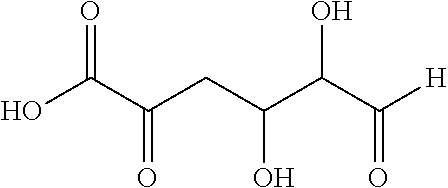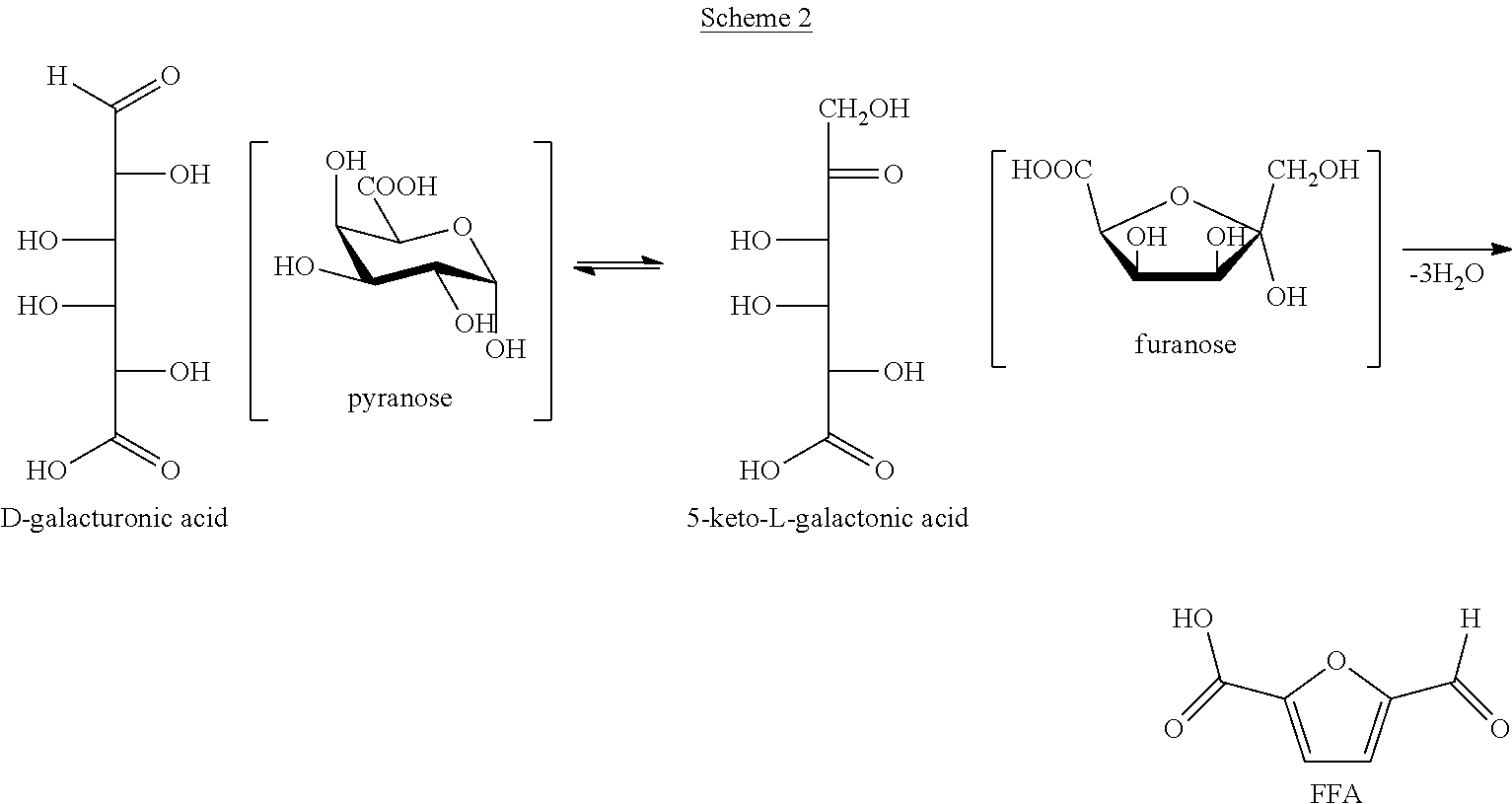Process and intermediates for the production of furan-2,5-dicarboxylic acid or derivatives thereof
a technology of dicarboxylic acid and intermediates, applied in the field of synthesis of furan2, 5dicarboxylic acid, can solve the problems of unstable biomass, potential conflict with food production, and lack of straightforward way of valorizing biomass, and achieve the effect of mild oxidation conditions
- Summary
- Abstract
- Description
- Claims
- Application Information
AI Technical Summary
Benefits of technology
Problems solved by technology
Method used
Image
Examples
example 2
Preparation of 5-keto-L-galactonic acid (mono-basic calcium salt) from D-galacturonic acid using aqueous calcium chloride and sodium hydroxide
[0048]Calcium chloride (2.62 g, 23.57 mmol) and D-galacturonic acid monohydrate (5 g, 23.57 mmol) were dissolved in 100 mL demineralized water to give a clear yellow solution (acidic pH). A concentrated solution of sodium hydroxide (1.89 g, 47.14 mmol) in demineralized water (10 mL) was added drop wise over a period of 5 min. After addition was complete, the resulting slightly turbid solution (alkaline pH) was placed in the refrigerator (7° C.) for 3 days. The formed crystals were collected by suction filtration. The initially transparent crystals were dried to a constant weight under vacuum at 40° C., over sicapent. The resulting 5-keto-L-galactonic acid (mono-basic calcium salt) was obtained as a bright yellow crystalline material (4.12 g, yield 70 mol %) and analyzed by 1H / 13C-NMR and IR.
example 3
Preparation of 5-keto-L-galactonic acid (mixture of the free acid and lactones) from 5-keto-L-galactonic acid (mono-basic calcium salt)
[0049]5-keto-L-galactonic acid (mono-basic calcium salt) (0.5 g, 2 mmol) was suspended in 50 mL demineralized water. Amberlite IR-120 resin (H+ form, 3 g) was added to the yellow suspension and the resulting mixture was placed in an ultrasonication bath for 10 min. Subsequently, the resin was separated by filtration and washed with 10 mL demineralized water. The combined clear aqueous solution was concentrated using a rotary evaporator at 60° C., and the resulting yellowish oil was further dried in a vacuum oven, 40° C., 50 mbar, over Sicapent for 19 h. The resulting 5-keto-L-galactonic acid (mixture of the free acid and lactones, 0.410 g, 106% yield) was obtained as a dark yellow gum, still containing a small amount of water.
example 4-6
Preparation of methyl 5-formyl-2-furoate (mixture of free aldehyde and dimethyl acetal) from 5-keto-L-galactonic acid (mono basic calcium salt)
[0050]General Procedure:
[0051]50 mL round bottom flasks were equipped with magnetic stirring bars, reflux condensers with N2-inlet and 5-keto-L-galactonic acid mono-basic calcium salt (1.0 g, 4 mmol). Methanolic HCl (3 M solution, 10 mL) was charged, upon which the yellow crystals dissolved immediately to give a clear colorless solution. The reaction mixtures were subsequently heated to reflux (65° C.) for the desired period of time. The resulting clear red-brown solutions were allowed to cool down to room temperature and 10 mL of demineralized water was added. After 45 min. the aqueous mixtures were extracted with diethyl ether (3×20 mL). The combined organic layers were then washed with brine until the pH of the water layer was neutral. The organic layers were dried over MgSO4, filtered and concentrated at 40° C. under vacuum using a rotary...
PUM
| Property | Measurement | Unit |
|---|---|---|
| pH | aaaaa | aaaaa |
| diameter | aaaaa | aaaaa |
| diameter | aaaaa | aaaaa |
Abstract
Description
Claims
Application Information
 Login to View More
Login to View More - R&D
- Intellectual Property
- Life Sciences
- Materials
- Tech Scout
- Unparalleled Data Quality
- Higher Quality Content
- 60% Fewer Hallucinations
Browse by: Latest US Patents, China's latest patents, Technical Efficacy Thesaurus, Application Domain, Technology Topic, Popular Technical Reports.
© 2025 PatSnap. All rights reserved.Legal|Privacy policy|Modern Slavery Act Transparency Statement|Sitemap|About US| Contact US: help@patsnap.com



